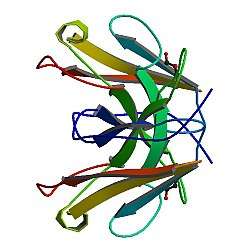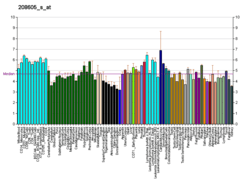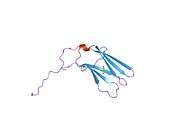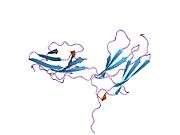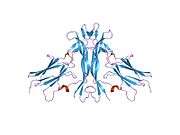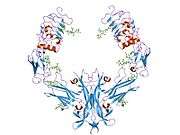Tropomyosin receptor kinase A
Tropomyosin receptor kinase A (TrkA),[5] also known as high affinity nerve growth factor receptor, neurotrophic tyrosine kinase receptor type 1, or TRK1-transforming tyrosine kinase protein is a protein that in humans is encoded by the NTRK1 gene.[6]
This gene encodes a member of the neurotrophic tyrosine kinase receptor (NTKR) family. This kinase is a membrane-bound receptor that, upon neurotrophin binding, phosphorylates itself (autophosphorylation) and members of the MAPK pathway. The presence of this kinase leads to cell differentiation and may play a role in specifying sensory neuron subtypes. Mutations in this gene have been associated with congenital insensitivity to pain with anhidrosis, self-mutilating behaviors, intellectual disability and/or cognitive impairment and certain cancers. Alternate transcriptional splice variants of this gene have been found, but only three have been characterized to date.[7]
Function
TrkA is the high affinity catalytic receptor for the neurotrophin, Nerve Growth Factor, or "NGF". As such, it mediates the multiple effects of NGF, which include neuronal differentiation and avoidance of programmed cell death.
Family members
TrkA is part of a sub-family of protein kinases which includes TrkB and TrkC. Also, there are other neurotrophic factors structurally related to NGF: BDNF (for Brain-Derived Neurotrophic Factor), NT-3 (for Neurotrophin-3) and NT-4 (for Neurotrophin-4). While TrkA mediates the effects of NGF, TrkB is bound and activated by BDNF, NT-4, and NT-3. Further, TrkC binds and is activated by NT-3.[8]
There is one other NGF receptor besides TrkA, called the "LNGFR" (for "Low Affinity Nerve Growth Factor Receptor"). As opposed to TrkA, the LNGFR plays a somewhat less clear role in NGF biology. Some researchers have shown the LNGFR binds and serves as a "sink" for neurotrophins. Cells which express both the LNGFR and the Trk receptors might therefore have a greater activity – since they have a higher "microconcentration" of the neurotrophin. It has also been shown, however, that in the absence of a co-expressed TrkA, the LNGFR may signal a cell to die via apoptosis – so therefore cells expressing the LNGFR in the absence of Trk receptors may die rather than live in the presence of a neurotrophin.
Role in disease
TrkA was originally cloned from a colon tumor; the cancer occurred via a translocation, which resulted in the activation of the TrkA kinase domain. However, TrkA itself does not appear to be an oncogene.
In one study, a total absence of TrkA receptor was found in keratoconus-affected corneas, along with an increased level of repressor isoform of Sp3 transcription factor.[9]
Gene fusions involving NTRK1 have been shown to be oncogenic, leading to the constitutive TrkA activation.[10] In a research study by Vaishnavi A. et al., NTRK1 fusions are estimated to occur in 3.3% of lung cancer as assessed through next generation sequencing or fluoresence in situ hybridization.[10]
Regulation
The levels of distinct proteins can be regulated by the "ubiquitin/proteasome" system. In this system, a small (7–8 kd)protein called "ubiquitin" is affixed to a target protein, and is thereby targeted for destruction by a structure called the "proteasome". TrkA is targeted for proteasome-mediated destruction by an "E3 ubiquitin ligase" called NEDD-4.[11] This mechanism may be a distinct way to control the survival of a neuron. The extent and maybe type of TrkA ubiquitiniation can be regulated by the other, unrelated receptor for NGF, p75NTR.
Interactions
TrkA has been shown to interact with:
Ligands
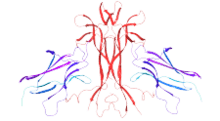
Small molecules such as amitriptyline and gambogic acid derivatives have been claimed to activate TrkA. Amitriptyline activates TrkA and facilitate the heterodimerisation of TrkA and TrkB in the absence of NGF. Binding of amitriptyline to TrkA occurs to the Leucine Rich Region (LRR) of the extracellular domain of the receptor, which is distinct from the NGF binding site. Amitryptiline possesses neurotrophic activity both in-vitro and in-vivo (mouse model).[29] Gambogic amide, a derivative of gambogic acid, selectively activates TrkA (but not TrkB and TrkC) both in-vitro and in-vivo by interacting with the cytoplasmic juxtamembrane domain of TrkA.[30]
Role in cancer
Although originally identified as an oncogenic fusion in 1982,[31] only recently has there been a renewed interest in the Trk family as it relates to its role in human cancers because of the identification of NTRK1 (TrkA), NTRK2 (TrkB) and NTRK3 (TrkC) gene fusions and other oncogenic alterations in a number of tumor types. A number of Trk inhibitors are (in 2015) in clinical trials and have shown early promise in shrinking human tumors.[32]
Inhibitors in development
Entrectinib (formerly RXDX-101) is an investigational drug developed by Ignyta, Inc., which has potential antitumor activity. It is a selective pan-trk receptor tyrosine kinase inhibitor (TKI) targeting gene fusions in trkA, trkB, and trkC (coded by NTRK1, NTRK2, and NTRK3 genes) that is currently in phase 2 clinical testing.[33]
References
- GRCh38: Ensembl release 89: ENSG00000198400 - Ensembl, May 2017
- GRCm38: Ensembl release 89: ENSMUSG00000028072 - Ensembl, May 2017
- "Human PubMed Reference:". National Center for Biotechnology Information, U.S. National Library of Medicine.
- "Mouse PubMed Reference:". National Center for Biotechnology Information, U.S. National Library of Medicine.
- Malenka RC, Nestler EJ, Hyman SE (2009). "Chapter 8: Atypical neurotransmitters". In Sydor A, Brown RY (eds.). Molecular Neuropharmacology: A Foundation for Clinical Neuroscience (2nd ed.). New York: McGraw-Hill Medical. ISBN 9780071481274.
Another common feature of neurotrophins is that they produce their physiologic effects by means of the tropomyosin receptor kinase (Trk) receptor family (also known as the tyrosine receptor kinase family). ...
Trk receptors
All neurotrophins bind to a class of highly homologous receptor tyrosine kinases known as Trk receptors, of which three types are known: TrkA, TrkB, and TrkC. These transmembrane receptors are glycoproteins whose molecular masses range from 140 to 145 kDa. Each type of Trk receptor tends to bind specific neurotrophins: TrkA is the receptor for NGF, TrkB the receptor for BDNF and NT-4, and TrkC the receptor for NT-3.However, some overlap in the specificity of these receptors has been noted. - Martin-Zanca D, Hughes SH, Barbacid M (April 1986). "A human oncogene formed by the fusion of truncated tropomyosin and protein tyrosine kinase sequences". Nature. 319 (6056): 743–8. doi:10.1038/319743a0. PMID 2869410.
- "Entrez Gene: NTRK1 neurotrophic tyrosine kinase, receptor, type 1".
- Benito-Gutiérrez E, Garcia-Fernàndez J, Comella JX (February 2006). "Origin and evolution of the Trk family of neurotrophic receptors". Mol. Cell. Neurosci. 31 (2): 179–92. doi:10.1016/j.mcn.2005.09.007. PMID 16253518.
- Lambiase A, Merlo D, Mollinari C, Bonini P, Rinaldi AM, D' Amato M, Micera A, Coassin M, Rama P, Bonini S, Garaci E (November 2005). "Molecular basis for keratoconus: lack of TrkA expression and its transcriptional repression by Sp3". Proc. Natl. Acad. Sci. U.S.A. 102 (46): 16795–800. doi:10.1073/pnas.0508516102. PMC 1283852. PMID 16275928.
- Vaishnavi, Aria; Capelletti, Marzia; Le, Anh T.; Kako, Severine; Butaney, Mohit; Ercan, Dalia; Mahale, Sakshi; Davies, Kurtis D.; Aisner, Dara L. (2013-11-01). "Oncogenic and drug-sensitive NTRK1 rearrangements in lung cancer". Nature Medicine. 19 (11): 1469–1472. doi:10.1038/nm.3352. ISSN 1546-170X. PMC 3823836. PMID 24162815.
- Yu T, Calvo L, Anta B, López-Benito S, Southon E, Chao MV, Tessarollo L, Arévalo JC (April 2011). "Regulation of trafficking of activated TrkA is critical for NGF-mediated functions". Traffic. 12 (4): 521–34. doi:10.1111/j.1600-0854.2010.01156.x. PMC 3547592. PMID 21199218.
- Koch A, Mancini A, Stefan M, Niedenthal R, Niemann H, Tamura T (March 2000). "Direct interaction of nerve growth factor receptor, TrkA, with non-receptor tyrosine kinase, c-Abl, through the activation loop". FEBS Lett. 469 (1): 72–6. doi:10.1016/S0014-5793(00)01242-4. PMID 10708759.
- Yano H, Cong F, Birge RB, Goff SP, Chao MV (February 2000). "Association of the Abl tyrosine kinase with the Trk nerve growth factor receptor". J. Neurosci. Res. 59 (3): 356–64. doi:10.1002/(SICI)1097-4547(20000201)59:3<356::AID-JNR9>3.0.CO;2-G. PMID 10679771.
- Meakin SO, MacDonald JI, Gryz EA, Kubu CJ, Verdi JM (April 1999). "The signaling adapter FRS-2 competes with Shc for binding to the nerve growth factor receptor TrkA. A model for discriminating proliferation and differentiation". J. Biol. Chem. 274 (14): 9861–70. doi:10.1074/jbc.274.14.9861. PMID 10092678.
- Song C, Perides G, Liu YF (February 2002). "Expression of full-length polyglutamine-expanded Huntingtin disrupts growth factor receptor signaling in rat pheochromocytoma (PC12) cells". J. Biol. Chem. 277 (8): 6703–7. doi:10.1074/jbc.M110338200. PMID 11733534.
- MacDonald JI, Gryz EA, Kubu CJ, Verdi JM, Meakin SO (June 2000). "Direct binding of the signaling adapter protein Grb2 to the activation loop tyrosines on the nerve growth factor receptor tyrosine kinase, TrkA". J. Biol. Chem. 275 (24): 18225–33. doi:10.1074/jbc.M001862200. PMID 10748052.
- Yamashita H, Avraham S, Jiang S, Dikic I, Avraham H (May 1999). "The Csk homologous kinase associates with TrkA receptors and is involved in neurite outgrowth of PC12 cells". J. Biol. Chem. 274 (21): 15059–65. doi:10.1074/jbc.274.21.15059. PMID 10329710.
- Nykjaer A, Lee R, Teng KK, Jansen P, Madsen P, Nielsen MS, Jacobsen C, Kliemannel M, Schwarz E, Willnow TE, Hempstead BL, Petersen CM (February 2004). "Sortilin is essential for proNGF-induced neuronal cell death". Nature. 427 (6977): 843–8. doi:10.1038/nature02319. PMID 14985763.
- Lee R, Kermani P, Teng KK, Hempstead BL (November 2001). "Regulation of cell survival by secreted proneurotrophins". Science. 294 (5548): 1945–8. doi:10.1126/science.1065057. PMID 11729324.
- Wiesmann C, Ultsch MH, Bass SH, de Vos AM (September 1999). "Crystal structure of nerve growth factor in complex with the ligand-binding domain of the TrkA receptor". Nature. 401 (6749): 184–8. doi:10.1038/43705. PMID 10490030.
- Ohmichi M, Decker SJ, Pang L, Saltiel AR (August 1991). "Nerve growth factor binds to the 140 kd trk proto-oncogene product and stimulates its association with the src homology domain of phospholipase C gamma 1" (PDF). Biochem. Biophys. Res. Commun. 179 (1): 217–23. doi:10.1016/0006-291X(91)91357-I. hdl:2027.42/29169. PMID 1715690.
- Qian X, Riccio A, Zhang Y, Ginty DD (November 1998). "Identification and characterization of novel substrates of Trk receptors in developing neurons". Neuron. 21 (5): 1017–29. doi:10.1016/S0896-6273(00)80620-0. PMID 9856458.
- Nakamura T, Komiya M, Sone K, Hirose E, Gotoh N, Morii H, Ohta Y, Mori N (December 2002). "Grit, a GTPase-activating protein for the Rho family, regulates neurite extension through association with the TrkA receptor and N-Shc and CrkL/Crk adapter molecules". Mol. Cell. Biol. 22 (24): 8721–34. doi:10.1128/MCB.22.24.8721-8734.2002. PMC 139861. PMID 12446789.
- Wooten MW, Seibenhener ML, Mamidipudi V, Diaz-Meco MT, Barker PA, Moscat J (March 2001). "The atypical protein kinase C-interacting protein p62 is a scaffold for NF-kappaB activation by nerve growth factor". J. Biol. Chem. 276 (11): 7709–12. doi:10.1074/jbc.C000869200. PMID 11244088.
- Geetha T, Wooten MW (February 2003). "Association of the atypical protein kinase C-interacting protein p62/ZIP with nerve growth factor receptor TrkA regulates receptor trafficking and Erk5 signaling". J. Biol. Chem. 278 (7): 4730–9. doi:10.1074/jbc.M208468200. PMID 12471037.
- Jadhav T, Geetha T, Jiang J, Wooten MW (July 2008). "Identification of a consensus site for TRAF6/p62 polyubiquitination". Biochem. Biophys. Res. Commun. 371 (3): 521–4. doi:10.1016/j.bbrc.2008.04.138. PMC 2474794. PMID 18457658.
- Wooten MW, Geetha T, Babu JR, Seibenhener ML, Peng J, Cox N, Diaz-Meco MT, Moscat J (March 2008). "Essential role of sequestosome 1/p62 in regulating accumulation of Lys63-ubiquitinated proteins". J. Biol. Chem. 283 (11): 6783–9. doi:10.1074/jbc.M709496200. PMID 18174161.
- Borrello MG, Pelicci G, Arighi E, De Filippis L, Greco A, Bongarzone I, Rizzetti M, Pelicci PG, Pierotti MA (June 1994). "The oncogenic versions of the Ret and Trk tyrosine kinases bind Shc and Grb2 adaptor proteins". Oncogene. 9 (6): 1661–8. PMID 8183561.
- Jang SW, Liu X, Chan CB, Weinshenker D, Hall RA, Xiao G, Ye K (June 2009). "Amitriptyline is a TrkA and TrkB receptor agonist that promotes TrkA/TrkB heterodimerization and has potent neurotrophic activity". Chem. Biol. 16 (6): 644–656. doi:10.1016/j.chembiol.2009.05.010. PMC 2844702. PMID 19549602.
- Jang SW, Okada M, Sayeed I, Xiao G, Stein D, Jin P, Ye K (October 2007). "Gambogic amide, a selective agonist for TrkA receptor that possesses robust neurotrophic activity, prevents neuronal cell death". Proc Natl Acad Sci U S A. 104 (41): 16329–16334. doi:10.1073/pnas.0706662104. PMC 2042206. PMID 17911251.
- Pulciani S, Santos E, Lauver AV, Long LK, Aaronson SA, Barbacid M (December 1982). "Oncogenes in solid human tumours". Nature. 300 (5892): 539–42. doi:10.1038/300539a0. PMID 7144906.
- Doebele RC, Davis LE, Vaishnavi A, Le AT, Estrada-Bernal A, Keysar S, Jimeno A, Varella-Garcia M, Aisner DL, Li Y, Stephens PJ, Morosini D, Tuch BB, Fernandes M, Nanda N, Low JA (October 2015). "An Oncogenic NTRK Fusion in a Patient with Soft-Tissue Sarcoma with Response to the Tropomyosin-Related Kinase Inhibitor LOXO-101". Cancer Discovery. 5 (10): 1049–57. doi:10.1158/2159-8290.CD-15-0443. PMC 4635026. PMID 26216294.
- "Promising entrectinib clinical trial data". ScienceDaily. 18 April 2016.
Further reading
- Indo Y (2002). "Genetics of congenital insensitivity to pain with anhidrosis (CIPA) or hereditary sensory and autonomic neuropathy type IV. Clinical, biological and molecular aspects of mutations in TRKA(NTRK1) gene encoding the receptor tyrosine kinase for nerve growth factor". Clin. Auton. Res. 12 (Suppl 1): I20–32. doi:10.1007/s102860200016. PMID 12102460.
- Micera A, Lambiase A, Stampachiacchiere B, Bonini S, Bonini S, Levi-Schaffer F (2007). "Nerve growth factor and tissue repair remodeling: trkA(NGFR) and p75(NTR), two receptors one fate". Cytokine Growth Factor Rev. 18 (3–4): 245–56. doi:10.1016/j.cytogfr.2007.04.004. PMID 17531524.
